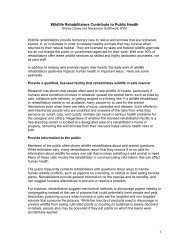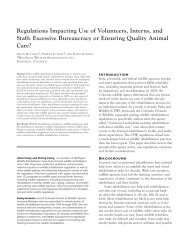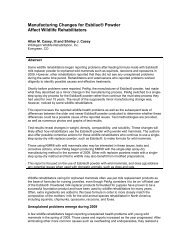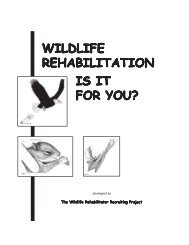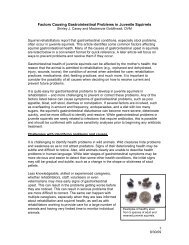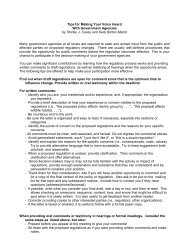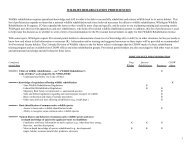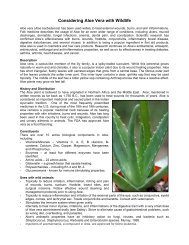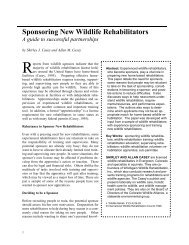1994 - WildAgain Wildlife Rehabilitation
1994 - WildAgain Wildlife Rehabilitation
1994 - WildAgain Wildlife Rehabilitation
Create successful ePaper yourself
Turn your PDF publications into a flip-book with our unique Google optimized e-Paper software.
182 Volume 23, Minneapolis, MN, 2005<br />
Table 18. Trends in New Regulations (eight states).<br />
General Permit Requirements<br />
8 Requires assisting veterinarian<br />
7 Not in conflict with local ordinances<br />
7 Initial facility inspection by agency<br />
4 Initially requires a sponsoring rehabilitator<br />
3 Does not authorize practice of vet. medicine<br />
Personal Qualifications<br />
6 Documented experience (200 hrs. to 2 yrs.)<br />
6 Rehabilitator reference (generally from sponsor)<br />
5 At least 18 years of age<br />
3 Initial training course required<br />
3 Will accept another state permit (for experience)<br />
3 Continuing education required<br />
Caging<br />
7 No public display & separation from domestics<br />
7 NWRA/IWRC Minimum Standards referenced<br />
Recordkeeping<br />
7 Submit annual report (generally year-end)<br />
4 Release location added to annual report<br />
Staffing / Donations<br />
5 Use of volunteers OK (including off-site care)<br />
4 May not charge for services (donations OK)<br />
Restricted / Prohibited Species<br />
5 Restricted species (generally RVS)<br />
4 Prohibitied species<br />
Release of Animals<br />
5 Euthansia standards or requirements specified<br />
4 Maximum holding time specified (180 days)<br />
4 Release location must be near capture point<br />
3 Obtain landowner permission prior to release<br />
3 No transfer / release across state lines<br />
3 Report any diseased animals<br />
agencies see the regulations as appearing to be stabilizing<br />
and perhaps maturing.<br />
It is also interesting to note that the areas receiving<br />
the highest number of changes during the <strong>1994</strong>–<br />
1999 time frame were essentially the same areas as<br />
during the most recent five years.<br />
Analysis–Trends in New<br />
Regulatory Systems<br />
Eight states adopted totally new regulations during the<br />
last five years (Figure 1), with most of them constituting<br />
a revamp of previously existing permit systems. A<br />
closer analysis of these new systems may likely help to<br />
anticipate changes seen in the future as other states<br />
adopt completely new regulations.<br />
The types of regulatory requirements seen most<br />
frequently in the new systems adopted by these eight<br />
states are shown in Table 18. The number to the left<br />
of each regulatory requirement indicates the number<br />
of states that now have that requirement.<br />
Analysis–Caging Standards<br />
Currently, 19 states make some reference to the<br />
Minimum Standards specifically as the document relates<br />
to caging and enclosures. As shown in Table 19, these<br />
states use differing language and terminology when<br />
referring to the extent to which the document should<br />
influence an applicant’s caging from “meet or exceed”<br />
to “guideline.” Additionally, states refer to different<br />
editions of the document, from the six states that cite<br />
the “current edition,” to the 13 states that refer to one<br />
of the three specific editions published since 1988.<br />
As shown in Table 20, this trend of inconsistently<br />
referring to the Minimum Standards among the states<br />
has continued even as new regulations have been<br />
adopted during the last five years. The outlined boxes<br />
indicate how seven of the eight states that have adopted<br />
new regulations that cite the Minimum Standards<br />
have referred to them when establishing caging regulations<br />
from the more strict “Meet or exceed” to only<br />
“Based on,” and from the “Current edition” all the<br />
way back to the second edition of the document.<br />
Further complicating this is the USFWS reference to<br />
only the third edition of the document (and not any<br />
future editions), and only as a “Guideline.”<br />
Issues<br />
Two broad issues emerged during this review and analysis<br />
of the regulations. The first is that sponsorship of<br />
new rehabilitators is becoming a more formal requirement.<br />
The second is the funding pressures facing state<br />
wildlife agencies.<br />
As discussed earlier, 16 states now require a formal<br />
apprenticeship period with another rehabilitator,<br />
double the states with a similar requirement in <strong>1994</strong>.<br />
The apprenticeship period in most cases lasts for a<br />
year or longer. This growing requirement prompts<br />
several key questions, such as do all rehabilitators<br />
make good sponsors or mentors? Where and how<br />
do the sponsors receive training on how to properly<br />
coach and train an apprentice? Are sponsors available<br />
to train and supervise new people when considering<br />
their own caseload demands? Are sponsors located<br />
in geographically proximate area to provide adequate




